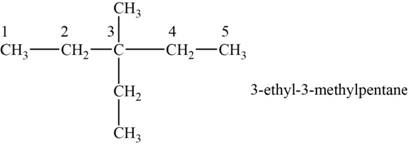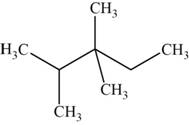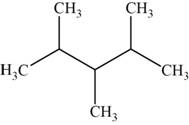
Concept explainers
Draw all the structural isomers for C8H18 that have the following root name (longest carbon chain). Name the structural isomers.
a. hexane
b. pentane
(a)
Interpretation: The structural isomers of C8H18 that have the root name hexane and pentane are to be drawn and their names are to be stated.
Concept introduction: Rules given by IUPAC should be followed to name an organic compound. Any organic compound has only one name that denotes that compound. The root word determines the number of carbons while counting the longest carbon chain. If more than one substituent is present, prefixes like di, tri, tetra, etc. are used and different substituents are written in alphabetical order.
Answer to Problem 16E
Answer
The structural isomers of C8H18 that have the root name pentane are drawn and their names have been rightfully stated.
Explanation of Solution
Explanation
To determine: The structural isomers of C8H18 that have the root name hexane.
The structural isomer is given below and its name is 3-ethylhexane.
The structure of the isomer is,

Figure 1
The general formula of alkanes is CnH2n. The given formula C8H18 satisfy the general formula of alkanes. Eight carbons means the the root word is “octane”. Thus the given formula signifies the organic compound octane.
Octane has eight carbons and 18 hydrogens. 3-ethylhexane also have eight carbons and 18 hydrogens, but its structure is different from octane. Therefore, 3-ethylhexane is a structural isomer of C8H18.
The isomer has six carbons in the parent chain. Therefore the root word “hexane” is used. Ethyl group is attached to third carbon, thus the name of the isomer is 3-ethylhexane.
The structural isomer is given below and its name is 2,2-dimethylhexane.
The structure of the isomer is,

Figure 2
The general formula of alkanes is CnH2n. The given formula C8H18 satisfy the general formula of alkanes. Eight carbons means the the root word is “octane”. Thus the given formula signifies the organic compound octane.
Octane has eight carbons and 18 hydrogens. 2,2-dimethylhexane also have eight carbons and 18 hydrogens, but its structure is different from octane. Therefore, 2,2-dimethylhexane is a structural isomer of C8H18.
The isomer has six carbons in the parent chain. Therefore the root word “hexane” is used. Two methyl groups are attached to second carbon, thus the name of the isomer is 2,2-dimethylhexane.
The structural isomer is given below and its name is 2,3-dimethylhexane.
The structure of the given isomer is,

Figure 3
The general formula of alkanes is CnH2n. The given formula C8H18 satisfy the general formula of alkanes. Eight carbons means the the root word is “octane”. Thus the given formula signifies the organic compound octane.
Octane has eight carbons and 18 hydrogens. 2,3-dimethylhexane also have eight carbons and 18 hydrogens, but its structure is different from octane. Therefore, 2,3-dimethylhexane is a structural isomer of C8H18.
The isomer has six carbons in the parent chain. Therefore the root word “hexane” is used. Methyl group is attached to second and third carbon, thus the name of the isomer is 2,3-dimethylhexane.
The structural isomer is given below and its name is 2,4-dimethylhexane.
The structure of the isomer is,

Figure 4
The general formula of alkanes is CnH2n. The given formula C8H18 satisfy the general formula of alkanes. Eight carbons means the the root word is “octane”. Thus the given formula signifies the organic compound octane.
Octane has eight carbons and 18 hydrogens. 2,4-dimethylhexane also have eight carbons and 18 hydrogens, but its structure is different from octane. Therefore, 2,4-dimethylhexane is a structural isomer of C8H18.
The isomer has six carbons in the parent chain. Therefore the root word “hexane” is used. Methyl group is attached to second and fourth carbon, thus the name of the isomer is 2,4-dimethylhexane.
The structural isomer is given below and its name is 2,5-dimethylhexane.
The structure of the isomer is,

Figure 5
The general formula of alkanes is CnH2n. The given formula C8H18 satisfy the general formula of alkanes. Eight carbons means the the root word is “octane”. Thus the given formula signifies the organic compound octane.
Octane has eight carbons and 18 hydrogens. 2,5-dimethylhexane also have eight carbons and 18 hydrogens, but its structure is different from octane. Therefore, 2,5-dimethylhexane is a structural isomer of C8H18.
The isomer has six carbons in the parent chain. Therefore the root word “hexane” is used. Methyl group is attached to second and fifth carbon, thus the name of the isomer is 2,5-dimethylhexane.
The structural isomer is given below and its name is 3,3-dimethylhexane.
The structure of the isomer is,

Figure 6
The general formula of alkanes is CnH2n. The given formula C8H18 satisfy the general formula of alkanes. Eight carbons means the the root word is “octane”. Thus the given formula signifies the organic compound octane.
Octane has eight carbons and 18 hydrogens. 3,3-dimethylhexane also have eight carbons and 18 hydrogens, but its structure is different from octane. Therefore, 3,3-dimethylhexane is a structural isomer of C8H18.
The isomer has six carbons in the parent chain. Therefore the root word “hexane” is used. Two Methyl groups are attached to third carbon, thus the name of the isomer is 3,3-dimethylhexane.
The structural isomer is given below and its name is 3,4-dimethylhexane.
The structure of the isomer is,

Figure 7
The general formula of alkanes is CnH2n. The given formula C8H18 satisfy the general formula of alkanes. Eight carbons means the the root word is “octane”. Thus the given formula signifies the organic compound octane.
Octane has eight carbons and 18 hydrogens. 3,4-dimethylhexane also have eight carbons and 18 hydrogens, but its structure is different from octane. Therefore, 3,4-dimethylhexane is a structural isomer of C8H18.
The isomer has six carbons in the parent chain. Therefore the root word “hexane” is used. Methyl groups are attached to third and fourth carbon, thus the name of the isomer is 3,4-dimethylhexane.
Conclusion
The structural isomers of C8H18 that have the root name hexane are drawn and their names have been rightfully stated.
(b)
Interpretation: The structural isomers of C8H18 that have the root name hexane and pentane are to be drawn and their names are to be stated.
Concept introduction: Rules given by IUPAC should be followed to name an organic compound. Any organic compound has only one name that denotes that compound. The root word determines the number of carbons while counting the longest carbon chain. If more than one substituent is present, prefixes like di, tri, tetra, etc. are used and different substituents are written in alphabetical order.
Explanation of Solution
Explanation
To determine: The structural isomers of C8H18 that have the root name pentane.
The structural isomer is given below and its name is 3-ethyl- 2-methylpentane.
The structure of the isomer is,

Figure 8
The general formula of alkanes is CnH2n. The given formula C8H18 satisfy the general formula of alkanes. Eight carbons means the the root word is “octane”. Thus the given formula signifies the organic compound octane.
Octane has eight carbons and 18 hydrogens. 3-ethyl- 2-methylpentane also have eight carbons and 18 hydrogens, but its structure is different from octane. Therefore, 3-ethyl- 2-methylpentane is a structural isomer of C8H18.
The isomer has five carbons in the parent chain. Therefore the root word “pentane” is used. Methyl group is attached to second carbon, ethyl group is attached to third carbon, therefore, the name of the isomer is 3-ethyl- 2-methylpentane.
The structural isomer is given below and its name is 3-ethyl- 3-methylpentane.
The structure of the isomer is,

Figure 9
The general formula of alkanes is CnH2n. The given formula C8H18 satisfy the general formula of alkanes. Eight carbons means the the root word is “octane”. Thus the given formula signifies the organic compound octane.
Octane has eight carbons and 18 hydrogens. 3-ethyl- 3-methylpentane also have eight carbons and 18 hydrogens, but its structure is different from octane. Therefore, 3-ethyl- 3-methylpentane is a structural isomer of C8H18.
The isomer has five carbons in the parent chain. Therefore the root word “pentane” is used. Methyl group and ethyl group is attached to third carbon, therefore, the name of the isomer is 3-ethyl- 3-methylpentane.
The structural isomer is given below and its name is 2,2,3-trimethylpentane.
The structure of the isomer is,

Figure 10
The general formula of alkanes is CnH2n. The given formula C8H18 satisfy the general formula of alkanes. Eight carbons means the the root word is “octane”. Thus the given formula signifies the organic compound octane.
Octane has eight carbons and 18 hydrogens. 2,2,3-trimethylpentane also have eight carbons and 18 hydrogens, but its structure is different from octane. Therefore, 2,2,3-trimethylpentane is a structural isomer of C8H18.
The isomer has five carbons in the parent chain. Therefore the root word “pentane” is used. Two methyl groups are attached to second carbon and one methyl group is attached to third carbon, therefore, the name of the isomer is 2,2,3-trimethylpentane.
The structural isomer is given below and its name is 2,2,4-trimethylpentane.
The structure of the isomer is,

Figure 11
The general formula of alkanes is CnH2n. The given formula C8H18 satisfy the general formula of alkanes. Eight carbons means the the root word is “octane”. Thus the given formula signifies the organic compound octane.
Octane has eight carbons and 18 hydrogens. 2,2,4-trimethylpentane also have eight carbons and 18 hydrogens, but its structure is different from octane. Therefore, 2,2,4-trimethylpentane is a structural isomer of C8H18.
The isomer has five carbons in the parent chain. Therefore the root word “pentane” is used. Two methyl groups are attached to second carbon and one methyl group is attached to fourth carbon, therefore, the name of the isomer is 2,2,4-trimethylpentane.
The structural isomer is given below and its name is 2,3,3-trimethylpentane.
The structure of the isomer is,

Figure 12
The general formula of alkanes is CnH2n. The given formula C8H18 satisfy the general formula of alkanes. Eight carbons means the the root word is “octane”. Thus the given formula signifies the organic compound octane.
Octane has eight carbons and 18 hydrogens. 2,3,3-trimethylpentane also have eight carbons and 18 hydrogens, but its structure is different from octane. Therefore, 2,3,3-trimethylpentane is a structural isomer of C8H18.
The isomer has five carbons in the parent chain. Therefore the root word “pentane” is used. Two methyl groups are attached to third carbon and one methyl group is attached to second carbon, therefore, the name of the isomer is 2,3,3-trimethylpentane.
The structural isomer is given below and its name is 2,3,4-trimethylpentane.
The structure of the isomer is,

Figure 13
The general formula of alkanes is CnH2n. The given formula C8H18 satisfy the general formula of alkanes. Eight carbons means the the root word is “octane”. Thus the given formula signifies the organic compound octane.
Octane has eight carbons and 18 hydrogens. 2,3,4-trimethylpentane also have eight carbons and 18 hydrogens, but its structure is different from octane. Therefore, 2,3,4-trimethylpentane is a structural isomer of C8H18.
The isomer has five carbons in the parent chain. Therefore the root word “pentane” is used. Methyl group is attached to second, third carbon and fourth carbon, therefore, the name of the isomer is 2,3,4-trimethylpentane.
Conclusion
The structural isomers of C8H18 that have the root name pentane are drawn and their names have been rightfully stated.
Want to see more full solutions like this?
Chapter 21 Solutions
Chemistry: An Atoms First Approach
- Show how to convert ethyl benzene to (a) 2,5-dichlorobenzoic acid and (b) 2,4-dichlorobenzoic acid.arrow_forwardHelp me solve this problem. Thank you in advance.arrow_forward22.7 Predict the monoalkylated products of the following reactions with benzene. (a) AlCl3 Ya (b) AlCl3 (c) H3PO4 (d) 22.8 Think-Pair-Share AICI3 The reaction below is a common electrophilic aromatic substitution. SO3 H₂SO4 SO₂H (a) Draw the reaction mechanism for this reaction using HSO,+ as the electrophile. (b) Sketch the reaction coordinate diagram, where the product is lower in energy than the starting reactant. (c) Which step in the reaction mechanism is highest in energy? Explain. (d) Which of the following reaction conditions could be used in an electrophilic aro- matic substitution with benzene to provide substituted phenyl derivatives? (i) AICI3 HNO3 H₂SO4 K2Cr2O7 (iii) H₂SO4 (iv) H₂PO₁arrow_forward
- Is an acid-base reaction the only type of reaction that would cause leavening products to rise?arrow_forwardHelp me understand this! Thank you in advance.arrow_forward22.22 For each compound, indicate which group on the ring is more strongly activating and then draw a structural formula of the major product formed by nitration of the compound. Br CHO (a) CH3 (b) (c) CHO CH3 SO₂H (d) ☑ OCHS NO₂ (e) (f) CO₂H NHCOCH3 NHCOCH, (h) CHS 22.23 The following molecules each contain two aromatic rings. (b) 000-100- H3C (a) (c) Which ring in each undergoes electrophilic aromatic substitution more readily? Draw the major product formed on nitration.arrow_forward
- V Consider this step in a radical reaction: Br: ? What type of step is this? Check all that apply. Draw the products of the step on the right-hand side of the drawing area below. If more than one set of products is possible, draw any set. Also, draw the mechanism arrows on the left-hand side of the drawing area to show how this happens. ⚫ionization termination initialization neutralization none of the abc Explanation Check 80 Ο F3 F1 F2 2 F4 01 % do5 $ 94 #3 X 5 C MacBook Air 25 F5 F6 66 ©2025 ˇ F7 29 & 7 8arrow_forwardShow how to convert ethyl benzene to (a) 2,5-dichlorobenzoic acid and (b) 2,4-dichlorobenzoic acid.arrow_forwardno aiarrow_forward
- Polymers may be composed of thousands of monomers. Draw three repeat units (trimer) of the polymer formed in this reaction. Assume there are hydrogen atoms there are hydrogen atoms on the two ends of the trimer. Ignore inorganic byproducts.arrow_forwardDraw a tetramer if this alternating copolymer pleasearrow_forwardDraw the monomers required to synthesize this condensation polymer.arrow_forward
 Chemistry for Today: General, Organic, and Bioche...ChemistryISBN:9781305960060Author:Spencer L. Seager, Michael R. Slabaugh, Maren S. HansenPublisher:Cengage LearningChemistry: Matter and ChangeChemistryISBN:9780078746376Author:Dinah Zike, Laurel Dingrando, Nicholas Hainen, Cheryl WistromPublisher:Glencoe/McGraw-Hill School Pub Co
Chemistry for Today: General, Organic, and Bioche...ChemistryISBN:9781305960060Author:Spencer L. Seager, Michael R. Slabaugh, Maren S. HansenPublisher:Cengage LearningChemistry: Matter and ChangeChemistryISBN:9780078746376Author:Dinah Zike, Laurel Dingrando, Nicholas Hainen, Cheryl WistromPublisher:Glencoe/McGraw-Hill School Pub Co World of Chemistry, 3rd editionChemistryISBN:9781133109655Author:Steven S. Zumdahl, Susan L. Zumdahl, Donald J. DeCostePublisher:Brooks / Cole / Cengage Learning
World of Chemistry, 3rd editionChemistryISBN:9781133109655Author:Steven S. Zumdahl, Susan L. Zumdahl, Donald J. DeCostePublisher:Brooks / Cole / Cengage Learning Introductory Chemistry: An Active Learning Approa...ChemistryISBN:9781305079250Author:Mark S. Cracolice, Ed PetersPublisher:Cengage Learning
Introductory Chemistry: An Active Learning Approa...ChemistryISBN:9781305079250Author:Mark S. Cracolice, Ed PetersPublisher:Cengage Learning Chemistry: The Molecular ScienceChemistryISBN:9781285199047Author:John W. Moore, Conrad L. StanitskiPublisher:Cengage Learning
Chemistry: The Molecular ScienceChemistryISBN:9781285199047Author:John W. Moore, Conrad L. StanitskiPublisher:Cengage Learning





